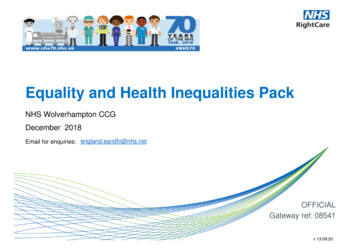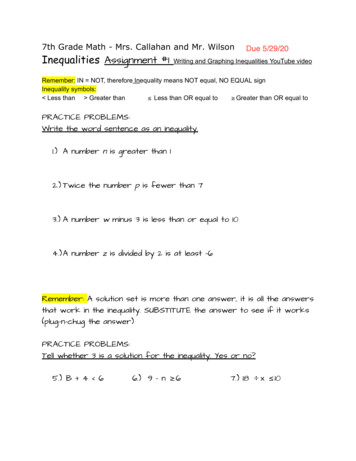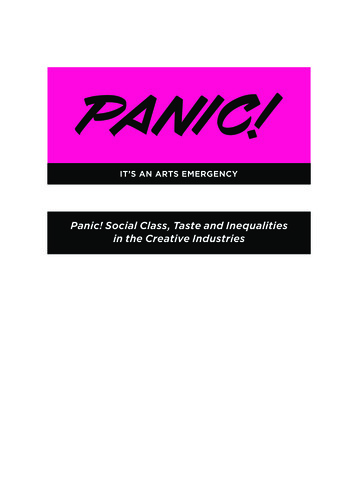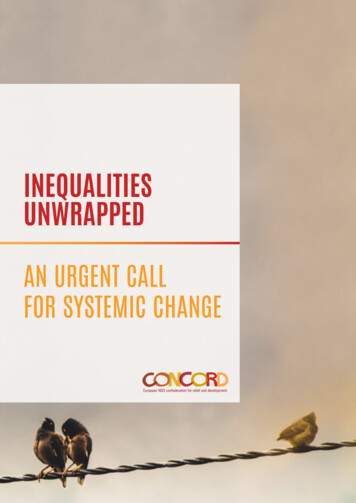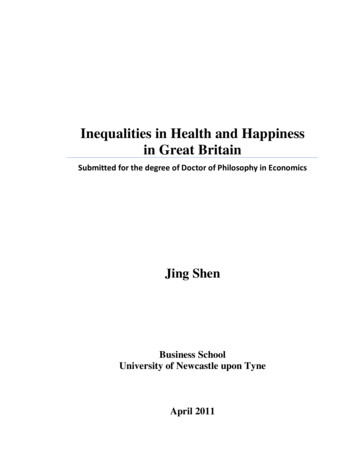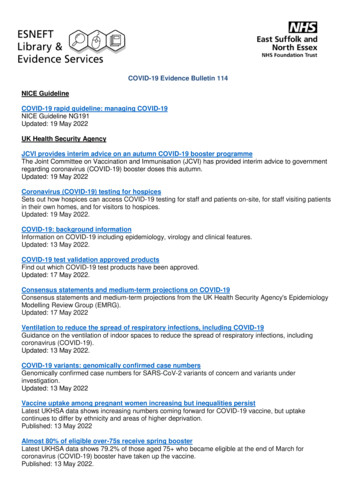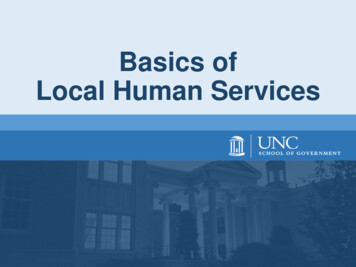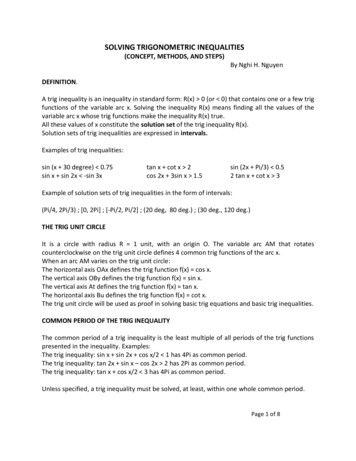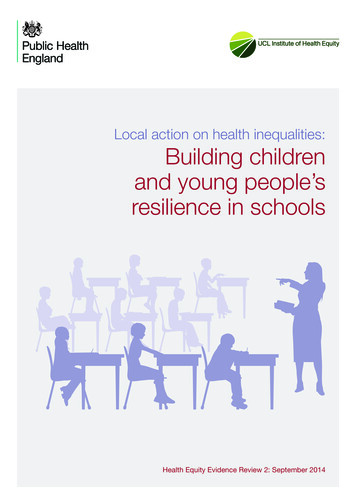
Transcription
Local action on health inequalities:Building childrenand young people’sresilience in schoolsHealth Equity Evidence Review 2: September 2014
Building children and young people’s resilience in schoolsAbout Public Health EnglandPublic Health England’s mission is to protect and improve the nation’s health and to addressinequalities through working with national and local government, the NHS, industry and thevoluntary and community sector. PHE is an operationally autonomous executive agency of theDepartment of Health.About the UCL Institute of Health EquityThe Institute is led by Professor Sir Michael Marmot and seeks to increase health equity throughaction on the social determinants of health, specifically in four areas: influencing global, nationaland local policies; advising on and learning from practice; building the evidence base; and capacitybuilding. The Institute builds on previous work to tackle inequalities in health led by Professor SirMichael Marmot and his team, including the ‘Commission on Social Determinants of Health’, ‘FairSociety Healthy Lives’ (The Marmot Review) and the ‘Review of Social Determinants of Health andthe Health Divide for the WHO European Region’. www.instituteofhealthequity.orgAbout this evidence reviewThis evidence review was commissioned by PHE and researched, analysed and written by theInstitute of Health Equity (IHE). There are related evidence reviews available in this series. Thereis a companion summary briefing note available on this and other related topics from the sameseries. This review is intended primarily for directors of public health, public health teams and localauthorities. This review and the accompanying briefing are part of a series commissioned byPHE to describe and demonstrate effective, practical local action on a range of social determinantsof health.This evidence review was written for IHE by Matilda Allen.We would like to thank all those on our advisory group who commented on the drafts of thisbriefing, with particular thanks to Bola Akinwale, Jessica Allen, Mel Bartley, Nicholas Beale,Fiona Brooks, David Buck, Ann Marie Connolly, Eustace DeSousa, Julie Dunning, Alex Godoy,Catherine Gregson, Catherine Johnson, Georgina Kyriacou, Michael Marmot, Claire Robsonand Lesley White. Crown copyright 2014. You may re-use this information (excluding logos) free of charge in anyformat or medium, under the terms of the Open Government Licence v2.0. To view this licence,visit OGL or email psi@nationalarchives.gsi.gov.uk. Where we have identified any third partycopyright information you will need to obtain permission from the copyright holders concerned.Public Health EnglandWellington House133-155 Waterloo RoadLondon SE1 8UGwww.gov.uk/pheTwitter: @PHE ukPHE publications gateway number: 2014334September 20142
Building children and young people’s resilience in schoolsContentsIntroduction41.What is resilience?52.Resilience and health inequalities82.1: Resilience and healthRisky health behavioursQualifications and skillsEmploymentMental wellbeingRecovery from illness2.2: Social inequalities and resilience88889993.Scale of the problem124.What works to increase resilience154.1: Who should act to build children’s resilience, and why16The role of schools in building resilience16The role of local authorities in supporting and encouraging schools to take action 174.2: Focusing on individualsImproving achievementsSupporting transitionsHealthy behaviours181821234.3: Addressing interpersonal issuesParents and carersTeachers and other staffFriends252528304.4: School and community level actionWhole school approachesThe school as a community hub3131335.4.5: Principles for implementation: proportionate universalism and prevention37Areas for further research39Conclusion40References413
Building children and young people’s resilience in schoolsKey messages1.Resilience is the capacity to ‘bounce back’ from adversity. Protective factors increaseresilience, whereas risk factors increase vulnerability. Resilient individuals, families andcommunities are more able to deal with difficulties and adversities than those with lessresilience.2.Those who are resilient do well despite adversity, although it does not imply that those whoare resilient are unharmed – they often have poorer outcomes than those who have low-riskbackground but less resilience. This applies to health outcomes and effects success in arange of areas of life across the life course. Evidence shows that resilience could contributeto healthy behaviours, higher qualifications and skills, better employment, better mentalwellbeing, and a quicker or more successful recovery from illness.3.Resilience is not an innate feature of some people’s personalities. Resilience and adversityare distributed unequally across the population, and are related to broader socio-economicinequalities which have common causes – the inequities in power, money and resourcesthat shape the conditions in which people live and their opportunities, experiences andrelationships.4.Those who face the most adversity are least likely to have the resources necessary to buildresilience. This ‘double burden’ means that inequalities in resilience are likely to contribute tohealth inequalities.5.Schools have a key opportunity to build resilience among children and young people, andthere is a range of ways in which local authorities can support and encourage schools totake action.6.Actions to inrease resilience can be targeted at different levels – they can aim to increaseachievements of pupils; to support them through transitions and encourage healthybehaviours; to promote better interpersonal relationships between people – particularlyparents or carers and children; and to create more supportive, cohesive schools that supportboth pupils and the wider community.4
Building children and young people’s resilience in schoolsIntroductionThe Marmot Review recognised the important role of schools in building resilience, andrecommended as a policy objective that, ‘schools, families and communities work in partnership toreduce the gradient in health, wellbeing and resilience of children and young people’.1This review builds on that position and provides a summary of evidence about the effect ofresilience on health, the unequal distribution of resilience and its contribution to levels of healthinequalities. The review outlines the potential actions that can be taken in schools in order tobuild resilience for all children and young people and reduce inequalities in resilience. Throughout,a social determinants approach to resilience is taken. Children and young people’s individualcharacteristics are seen as shaped by, and related to, inequities in power, money and resources,and the conditions in which they are born, grow, live, and in which they will work and age.2 Familyand community resilience are highly significant and similarly shaped by wider social and economicfactors.The focus is on children and young people aged five to 18, in primary and secondary schoolsettings. There is good evidence about what works to build protective factors and reduce riskfactors in schools in order to promote wellbeing, and some evidence specifically on buildingresilience. The purpose of this document is to show that taking action on resilience is possible andnecessary – to build resilience as a goal in its own right, but also as an important way to improvepublic health and reduce inequalities in health and in other desirable outcomes.This paper is part of a collection of evidence reviews commissioned by Public Health England(PHE) and written by the UCL Institute of Health Equity. It is intended to support directors of publichealth and their teams within local authorities, health and wellbeing boards, councillors, schoolstaff, and others with an interest in health inequalities, education and wellbeing in their local area. Acorresponding briefing on this topic area is also available, alongside the further evidence reviews.Of particular interest in relation to resilience are the evidence reviews on parenting programmes,the transition from home to school, and young people not in employment, education andtraining (NEET).Throughout the paper, we have highlighted certain evidence and resources in boxes such as thisone. These are labelled in the following ways:Intervention – an example of a strategy, programme or initiative, taken by a local area,organisation or national government, that it is felt may contribute to reducing health inequalitiesby acting on the social determinants of health. It has either been evaluated and shown to beeffective, or is considered to be an example of promising action.Key Message(s) – summaries of the key findings or action proposed in this paper.Key literature – summaries of academic studies or other reports which provide key informationrelevant to the chapter, often taking into account a range of different programmes or projects.5
Building children and young people’s resilience in schools1. What is resilience?Resilience is described as the capacity to ‘bounce back’ from adverse experiences, and succeeddespite adversity. Adversity can be defined as a lack of positive circumstances or opportunities,partly brought about by physical, mental or social losses or deprivation3, or the experienceof trauma. Resilience has been defined as the ‘opposite’ of vulnerability3-5. Some researchcharacterises resilient individuals as having average or expected outcomes; others emphasiseflourishing (i.e. doing better than average). 3, 6, 7 In this paper we include both.Resilience has been defined as an individual personality trait, and dependent on innatecharacteristics.8, 9 However, evidence summarised in this review demonstrates that the conditionsin which people are born, grow, live, work and age shape their capacity to respond to externalshocks or adversity without experiencing significant harm. In this way, the family, community, social,cultural, and economic environments in which we live, the opportunities available to us and ourexperiences across the life course all shape the outcomes we experience in the face of adversity.10,11Resilience interacts with, but is not ‘created’ by, characteristics of individuals. Rather, it is shapedand built by experiences, opportunities and relationships12-14 – what could be termed the ‘socialdeterminants’ of resilience.The impact of the environment, experiences and opportunities on people’s resilience occursthrough the development of either risk or protective factors. Risk factors are more likely to lead tovulnerability while protective factors are more likely to increase resilience. When we face adversity,vulnerability increases the chances of negative outcomes, whereas resilience can enable us toachieve positive outcomes, including good health. Therefore, building resilience requires actionto maximise protective factors and minimise risk factors.15 These factors are described further insection 3.This definition of resilience is also informed by a capabilities approach. ‘Capabilities’ are describedby Sen and Nussbaum as the capacity of individuals to ‘do and be that which they have reason tovalue’.16 Capabilities are shaped by the conditions in which people live, and their experiences andopportunities, similar to the social determinants approach which we outline above.Capabilities, like resilience, enable us to be able to withstand adversity, shock or disadvantage. Theconcept of resilience is also similar to the idea of ‘competence’: competent people are defined asthose who have the abilities “to generate and coordinate flexible, adaptive responses to demandsand to generate and capitalize on opportunities in the environment”.176
Building children and young people’s resilience in schoolsThis paper refers not only to the resilience of individuals but also to the resilience of families andcommunities. For example, a local community that has good health compared to the nationalaverage or a similar community, without having significantly more wealth, might be seen as beingresilient. Community resilience impacts on individuals’ resilience: those who grow up in resilientcommunities are themselves likely to be more resilient.Key literature: resilience in older agesA growing body of research on resilience in older age (usually 65 ) provides insight into theimpacts that resilience has, what protects individuals and communities against the negativeimpacts of adversity, and what can be done at the start of life in order to ensure resilience ismaintained across the life course. Interesting findings, particularly in the area of social protectivefactors, include the following: resilience is, in part, dependent on the level of adversity. More severe adversity results invulnerable outcomes, despite protective resources.3, 5 This also applies to the number ofadversities experienced6, 7 older people with resilient outcomes have been shown to have resources that stabilisedlife change by providing continuity (such as social roles and activities and close ongoingrelationships)3, 5 integration into a community has been shown to be a protective factor that increasesresilience among older adults6 research using longitudinal data that examined ‘bouncing back’ after adversity among olderadults found that the only variable that was consistently related to resilience was socialsupport (having people who are trusted and can help in a crisis). The study did not find apsychological profile for having more or less resilience7This social determinants approach to community and individual resilience involves four furtherfeatures. Firstly, resilience is a dynamic process18-20 and is developmental – it can accumulate anddevelop (or reduce) over time.14 Changes in resilience over the life course are likely to be relatedto the experiences of individuals, families, and communities and wider social, economic andpolitical factors.Secondly, resilient individuals and communities are not unharmed or invulnerable.13 They displaybetter outcomes than those who are not so resilient, but they rarely achieve as good results asthose who have not experienced similar adversity, stress or disadvantage.12, 21 For this reason,resilient children living in disadvantaged areas tend to have lower overall outcomes than childrenwho lack resilience but live in low-risk environments. 22, 23Thirdly, even highly resilient individuals cannot overcome all adversity. For example, evidencesuggests that very few children manage to be resilient in the face of severe abuse and neglect, ormultiple adversities such as having a parent with mental illness, while living in poverty and havinglittle social support.22, 24-26Finally, since there are inequalities in the determinants of resilience, there are also likely to beinequalities in levels of resilience, which relate to broader socio-economic inequalities in power,money and resources. This is examined further in section 2.2.7
Building children and young people’s resilience in schools2. Resilience and health inequalities2.1: Resilience and healthRisky health behavioursRisky health behaviours among young people include tobacco smoking, drinking alcohol, illicitdrug use and unprotected sex. The evidence suggests that these behaviours tend to clustertogether, and there is evidence of a social gradient, where those from more disadvantaged socioeconomic groups are more likely to engage in risky behaviours and in multiple risky behaviours. 27,28Engaging in risky behaviours has a direct impact on young people’s health, and is also likely toaffect performance and experience in schools. Risky health habits can also persist into adulthood,leading to lifelong negative effects on health.29, 30 For these reasons, reducing risky behaviour canhave an immediate positive impact on educational attainment as well as longer-termpositive impacts.Building resilience in young people may help to protect against engaging in risky health behaviour,and improve health and health behaviours.12 Resilience among young people can also help todelay ‘transitions’ such as parenthood,12 which can help to avoid the potential negative healthconsequences of early pregnancy for both parents and babies.Qualifications and skillsAcademic attainment is linked to health as there is strong evidence that those who do wellacademically are more likely to be healthy, with longer life expectancy, than those who achieve lessgood results.1, 31, 32 For example, data shows that highly literate adults are at least twice as likely toearn more, have political efficacy, volunteer, trust others, be employed and be in good health, thanthose with lower literacy.33 In the UK, those who have no qualifications are over two times as likelyto have a limiting illness than those who achieved university level (or equivalent) education.1 Theeffects of low academic achievement on mental health can occur before adulthood: almost halfof young people with fewer than five GCSEs at A* to C said they ‘always’ or ‘often’ felt down ordepressed compared with 30% of those who were more qualified.34 There is also a clear gradientin educational attainment correlating with socio-economic position and deprivation.1There is literature to suggest that improving resilience may improve academic results,12, 35 andsome evidence that resiliency-building programmes have increased academic attainment incertain subjects.36 This is a two-way relationship, as better academic attainment can also act as aprotective factor against adversity and therefore build resilience.EmploymentThere is strong evidence that good quality employment is beneficial for physical and mental health(see the ‘Employment’ evidence review in this series for more details).1, 31, 32Resilience may improve an individual’s performance in the labour market, reducing the chancesof unemployment or low quality, low paid work. Research shows that those who have a high8
Building children and young people’s resilience in schoolslevel of ‘non-cognitive skills’ are more likely to have better employment outcomes. These skillsinclude resilience and coping.37 This partly occurs by leading on from better attainment at school.Resilience may also equip individuals with a greater capacity to find and keep good quality work.Mental wellbeingMental wellbeing has an effect on physical and mental health outcomes38 and overall levels ofhealth inequalities. For this reason, where resilience-building increases mental wellbeing and mentalhealth, this is likely to improve the health of individuals and communities. Hammond and Feinsteinhave reported on an association between ‘flourishing’ at secondary school and adult healthoutcomes, over and above the effect that could be explained by academic success.39Resilience can be thought of as an essential component of mental wellbeing – and programmesthat increase mental wellbeing may do this partly through impacting on resilience. Similarly, goodmental health shares common causes with resilience.Recovery from illnessThere is some evidence that resilience is associated with quicker and better recovery from illness,12in part through social relationships40 or social capital.41 For example, emotional support hasbeen shown to be independently related to lower risk of death after myocardial infarction in olderpeople,42 and positive expectations tend to predict physical recovery after a heart transplant.43Those with adequate social relationships have been shown to have a 50% greater survival ratethan those with poor social relationships.44 There is more limited evidence available on youngpeople specifically, but there is research to show that social support may help young people withdepression.452.2: Social inequalities and resilienceThere is a lack of clear evidence that specifically shows inequalities, or a socio-economic gradient,in the distribution of resilience, partly because data on the prevalence of resilience has not beengathered on a large enough scale, and because measurement is complex. However, there areinequalities in adversity, and in protective resources.Firstly, some people are more likely to face regular and significant adversity in their lives thanothers, thus requiring higher levels of resilience. Adversity is defined as damaging or negativeenvironmental, social, economic or other factors, which are cumulative,26 and tend to cluster.13 Forexample, children living in poverty often also experience family difficulties or unhealthy housing.13,46Studies show that children who are exposed to adverse childhood experiences tend to have ahigher risk of unhealthy behaviours, poor mental wellbeing, and poor educational and employmentoutcomes.47-49 Exposure to these experiences is unequally distributed: one study found that thosewho experienced four or more adverse childhood experiences were significantly more likely to livein deprived areas.50There are also inequalities in the distribution of risk or adversity in the environment: for example,areas of higher deprivation are more likely to have lower quality housing, or have higher levels ofcrime.1 These factors are distributed along a social gradient: those who are at the bottom of thegradient (living with higher deprivation or in a lower socio-economic position) are more likely toexperience more frequent and more severe adversity,1 putting them in greater need of resiliencethan those further up the gradient.9
Building children and young people’s resilience in schoolsSecondly, not everyone has the same opportunity to access and develop the resources that arenecessary to build and strengthen resilience. Poverty is likely to limit the extent to which capabilitiesand resilience can be built and which have a positive impact on health.51 Many of those in greatestneed of resilience find it hardest to access the resources required to build protective factors:resources such as education and employment opportunities, decent housing, sufficient income,and healthy local areas (as described in the Marmot Review).1 For example, research shows thatopportunities for participation in education and employment, particularly important for doing well inthe face of adversity,14 are lesser in areas of deprivation or for those of low socio-economic status.Considering this ‘double burden’ – a greater incidence of adversity and a lower level of resourcesand opportunities from which to build resilience – it is likely that there is a gradient in outcomes,and that children and young people from poorer, more disadvantaged backgrounds are moresusceptible to worse health and other negative outcomes due to a lack of resilience and greaterexperience of adversity.These inequalities in resilience may result in inequalities in social and emotional adjustmentthroughout childhood, as seen in figure 1:Figure 1. Rates of poor social/emotional adjustment at ages 7, 11 and 16, by father’s social class atbirth, 1958 National Child Development Study% poor adjustment2520151050I/IIIINMIIIMIV/VSocial class at birthaged 7aged 11aged 16Source: (1)Survey data also shows that children who are materially deprived have reported lower levelsof choice and control and more negative feelings about the future. Children who experiencedeprivation are less likely to feel positive about the future.52 Longitudinal data has shown alinear relationship between factors such as poverty, parent conflict, separation and parent-childinteraction, and the incidence of psychosocial problems at 15-16 years of age.4, 53 Finally, evidenceshows that anxiety, aggression, confidence, emotional and cognitive development, concentration,and readiness for school are all graded by socio-economic status.12 Inequalities in all of these areasare likely to reflect and contribute to inequalities in resilience, as the presence of damaging riskfactors and the absence of protective factors increases vulnerability and reduces resilience.10
Building children and young people’s resilience in schools3. Scale of the problemMeasuring resilience is complex. A methodological review of resilience measurement scalesfound 15 measures of resilience, but no ‘gold standard’.54 The review reported favourably on theConnor-Davidson Resilience Scale, the Resilience Scale for Adults and the Brief Resilience Scale;however, none of these is applicable to children. There is an adaptation of the Connor-DavidsonResilience Scale for young adults, which could be informative.55 Similarly, the ‘Healthy Kids Survey’has a resilience and youth development module.56 However, this did not score well in the review ofresilience scales.54As explained in section 1, resilience depends in part on the levels of protective and risk factors.Measuring these can, therefore, give a good indication of the likely levels of resilience in the face ofadversity.Some of the studies mentioned throughout this document take this approach. In addition,outcome scales for young children can be informative. ‘Measuring what matters: a guide forchildren’s centres’ sets out a suite of indicators to measure good early child development in theareas of children’s health and development, parenting skills, the context of parenting, and later lifeoutcomes.57 Where children display positive outcomes in these areas, they are more likely to beexposed to the protective factors necessary for resilience building. Other protective factors includeachievement and attainment at school, successful transitions, good relationships with parents,teachers and peers, a supportive school environment, and community social capital, resources,services and connectedness. At a wider level, protective factors include a lack of poverty anddeprivation. The Centre for Mental Health lists protective factors for community resilience as beingpositive social networks, access to positive opportunities such as education, and participation incommunity activities.58 Risk factors include the opposite of many of these features – for example,low achievement in school or neglectful or unsupportive family relationships. At a community level,factors such as socio-economic disadvantage and poor housing conditions can increase risk.58Measuring the incidence of these risk and protective factors can indicate likely levels of resilienceand vulnerability.Some data that relate to resilience are also gathered at national levels. For example, studies havemeasured resilience in terms of good mental health, functional capacity, and social competence,4or quality of life.3 Survey data such as the Children’s Society publication ‘The good childhoodreport’,52 or measures of social and emotional adjustment such as the National Child DevelopmentStudy, can be instructive. Other national measures of relevance include UNICEF’s ‘child wellbeing’index, in which the UK is rated fourteenth out of 29 richest countries in terms of child wellbeing;59see figure 2.11
Building children and young people’s resilience in rkUnited KingdomItalyAustriaLuxembourgFranceCzeck RepublicLatviaPortugalGermanyUnited 83.882.982.581.379.776.6100%% of children aged 11, 13 and 15 with scores above the middle of a life satisfaction scaleFigure 2. National variations in children’s subjective wellbeingSource: (52)At a local level, there are a number of informative sources of data. The Child and Maternal HealthIntelligence Network (CHIMAT)60 provides figures on a range of wellbeing indicators for schoolaged children and young people, by local authority area. They also provide a children and youngperson’s mental health benchmarking tool, and links to a range of resources on emotionalwellbeing for children and young people.6112
Building children and young people’s resilience in schoolsFigure 3 is taken from the CHIMAT website, and provides the child wellbeing index average scorefrom 2009, by upper tier local authority in England. The index compiles data from a number ofdomains that reflect risk and protective resources, including material wellbeing, health, education,crime, housing, environment and children in need.62 The darker the shade, the lower the level ofwellbeing (white shading indicates that data was not available).Figure 3. Child wellbeing index average score, upper-tier local authority, England, 2009Source: (63)There are also tools that schools can use, such as the strengths and difficulties questionnaire(SDQ).64 The SDQ is widely used across the UK – for example, British local authorities are requiredto measure the mental health of looked after children using this tool.65 The quality of other localhealth services can also be assessed using the Department of Health ‘You’re Welcome’ qualitycriteria.66The Office for Standards in Education, Children’s Services and Skills (Ofsted) publishes an indicatorof whether ‘Children and young people’s views are listened to a ‘great deal/fair amount’’.67 TheOffice for National Statistics (ONS) is also conducting a large-scale analysis of wellbeing levels inthe UK, down to a local level, including indicators such as “feeling that you can overcome yourdifficulties” but this is currently only gathered for those aged 16 and over.68 In order to gatherdata on wellbeing from children and young people, specific tools and questionnaires are oftennecessary, as those designed for adults are not always wholly appropriate.13
Building children and young people’s resilience in schoolsSchools and local authorities can work together to gather data on local children’s outcomes,using the measures mentioned in this section, as well as other local sources of data. As well asmeasuring outcomes similar to resilience, such as emotional wellbeing, it is necessary to measurerisk and protective factors that may enable children and young people to have a resilient response
Building children and young people's resilience in schools 5 The Marmot Review recognised the important role of schools in building resilience, and recommended as a policy objective that, 'schools, families and communities work in partnership to reduce the gradient in health, wellbeing and resilience of children and young people'.1
